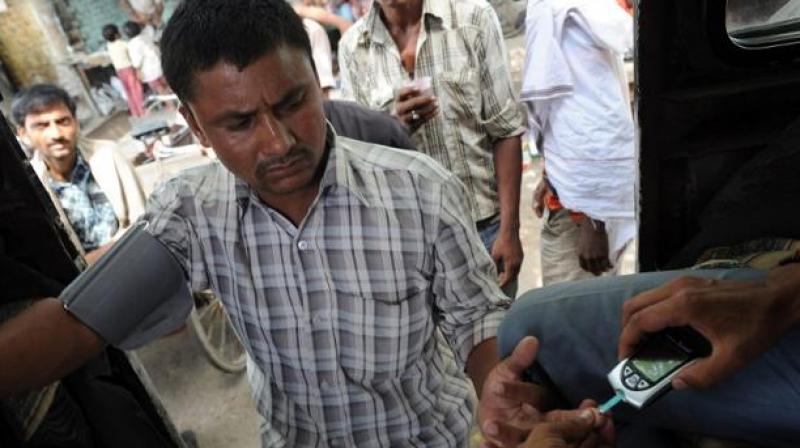Public health experts in India said that the presence of body fat, abdominal fat, pancreatic fat and a lower lean mass than white people are contributing to more metabolic and cardiovascular disease in Indians.
According to the article “Obesity, Diabetes and Cardiovascular Diseases in India: Public Health Challenges” published in Current Diabetes Review, the categorisation of obesity based on BMI levels, as used in the West, does not accurately reflect the metabolic risk in Indians. According to experts, a clear political will and concerted efforts from multiple stakeholders could help counter the increasingly difficult challenge.
Experts found nutrition and lifestyle transitions as primary reasons for the increase in non-communicable diseases, including coronary heart disease and type-2 diabetes, in India. Such diseases cause nearly 5.8 million deaths per year in the country.
Experts said that, though it is diffuclt to reverse and decrease the pace at which these diseases are affecting Indians, it is not impossible. “To tackle the juggernaut of diabetes and heart disease in India, innovative strategies are agressively needed. One such move is preventive and management care at the doorsteps of the underserved population using customised mobile vans, which we have used successfully in Delhi,” said Dr Anoop Misra, chairperson of Fortis-C-DOC Centre of Excellence for Diabetes, Metabolic Diseases and Endocrinology, and one of the contributors to the article.
Experts felt that concerted efforts from multiple stakeholders, intensely focused attention from health officials and clear political will could help counter this increasingly difficult challenge, the article said.
According to the article, written after the compilation of various studies conducted at national and international level, the South Asian region — which is home to more than 1.7 billion people — is currently experiencing a marked demographic transition characterised by declining birth and death rates and an increasingly ageing population.
“This increase in longevity has led to a rapid increase in the prevalence of NCDs like CVD, diabetes (78 million cases in 2015), cancer, and chronic pulmonary disease, due in large part to increasing lifetime exposure to risk factors,” it added.
In India, non-communicable diseases (NCDs) accounted for 60 per cent of all deaths and 44 per cent of disability-adjusted life-years (DALYs) lost in 2011. They were estimated to be responsible for 40 per cent of all hospital admissions and 35 per cent of all out-patient visits in 2004 in India. The prevalence of obesity is observed to be higher in women than men.
In a multi-site study conducted in India on 4,608 women over 35 years of age using WHO cut-offs for obesity, 33.2 per cent of rural and 46.6 per cent of urban women were overweight.
Experts said that the people of South Asia tend to have higher body fat, abdominal fat, liver fat, pancreatic fat and lower lean mass along with increased insulin resistance and dysmetabolic state when compared to white people.
The prevalence of abdominal obesity was found to be high even in underprivileged populations residing in urban slums of Delhi. Another recent study reported that 68.9 per cent subjects (62.2 per cent males and 74.8 per cent females) of the urban population of Delhi had abdominal obesity.
Infact, a ICMR-INDIAB study, found that the prevalence of abdominal obesity varied from 16.9% in Jharkhand to 36.3% in Chandigarh. India has more than 69 million people with Type 2 Diabetes Mellitus, and these numbers are expected to rise to 140 million by 2040, and an almost half of them remain undiagnosed. Moreover, Asian Indians have one of the highest incidence rates of pre-diabetes and diabetes among all major ethnic groups.
Experts therefore say that there is a clear need for planning strategies with an integrated approach to tackle the burden of obesity, diabetes and CVD in India. “Comprehensive, persistent and inter-linked efforts from multiple stakeholders, focused attention from health officialdom and clear political will can make some inroads in this increasingly difficult challenge.
A countrywide concerted approach, like carried out in China, isneeded for both communicable diseases, and NCDs, but more innovative and intense for latter because of inherent difficulties in controlling it in a resource-constraint setting”




 Driving Naari Programme launched in Chandigarh
Driving Naari Programme launched in Chandigarh































